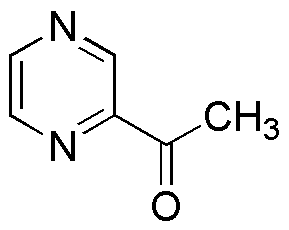2-Acetylpyrazine is widely utilized in research focused on:
- Flavoring Agents: This compound is commonly used in the food industry to enhance the flavor profile of various products, particularly in baked goods and snacks, providing a nutty, roasted aroma.
- Fragrance Formulations: In the cosmetics and personal care industry, it serves as a key ingredient in perfumes and scented products, contributing to complex fragrance compositions.
- Pharmaceutical Applications: It is explored in medicinal chemistry for its potential therapeutic properties, particularly in developing drugs targeting neurological disorders.
- Agricultural Chemicals: The compound is investigated for use in agrochemicals, where it can act as a natural attractant for beneficial insects, aiding in pest management strategies.
- Research in Material Science: 2-Acetylpyrazine is studied for its role in synthesizing novel materials, including polymers and coatings, due to its unique chemical properties.
General Information
Properties
Safety and Regulations
Applications
2-Acetylpyrazine is widely utilized in research focused on:
- Flavoring Agents: This compound is commonly used in the food industry to enhance the flavor profile of various products, particularly in baked goods and snacks, providing a nutty, roasted aroma.
- Fragrance Formulations: In the cosmetics and personal care industry, it serves as a key ingredient in perfumes and scented products, contributing to complex fragrance compositions.
- Pharmaceutical Applications: It is explored in medicinal chemistry for its potential therapeutic properties, particularly in developing drugs targeting neurological disorders.
- Agricultural Chemicals: The compound is investigated for use in agrochemicals, where it can act as a natural attractant for beneficial insects, aiding in pest management strategies.
- Research in Material Science: 2-Acetylpyrazine is studied for its role in synthesizing novel materials, including polymers and coatings, due to its unique chemical properties.
Documents
Safety Data Sheets (SDS)
The SDS provides comprehensive safety information on handling, storage, and disposal of the product.
Product Specification (PS)
The PS provides a comprehensive breakdown of the product’s properties, including chemical composition, physical state, purity, and storage requirements. It also details acceptable quality ranges and the product's intended applications.
Certificates of Analysis (COA)
Search for Certificates of Analysis (COA) by entering the products Lot Number. Lot and Batch Numbers can be found on a product’s label following the words ‘Lot’ or ‘Batch’.
*Catalog Number
*Lot Number
Certificates Of Origin (COO)
This COO confirms the country where the product was manufactured, and also details the materials and components used in it and whether it is derived from natural, synthetic, or other specific sources. This certificate may be required for customs, trade, and regulatory compliance.
*Catalog Number
*Lot Number
Safety Data Sheets (SDS)
The SDS provides comprehensive safety information on handling, storage, and disposal of the product.
DownloadProduct Specification (PS)
The PS provides a comprehensive breakdown of the product’s properties, including chemical composition, physical state, purity, and storage requirements. It also details acceptable quality ranges and the product's intended applications.
DownloadCertificates of Analysis (COA)
Search for Certificates of Analysis (COA) by entering the products Lot Number. Lot and Batch Numbers can be found on a product’s label following the words ‘Lot’ or ‘Batch’.
*Catalog Number
*Lot Number
Certificates Of Origin (COO)
This COO confirms the country where the product was manufactured, and also details the materials and components used in it and whether it is derived from natural, synthetic, or other specific sources. This certificate may be required for customs, trade, and regulatory compliance.


